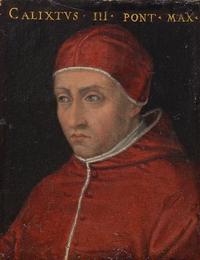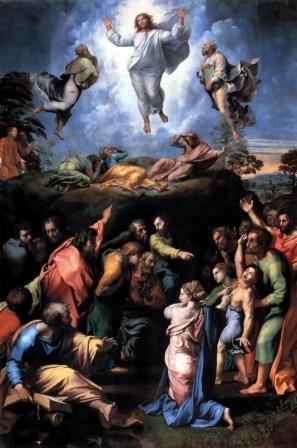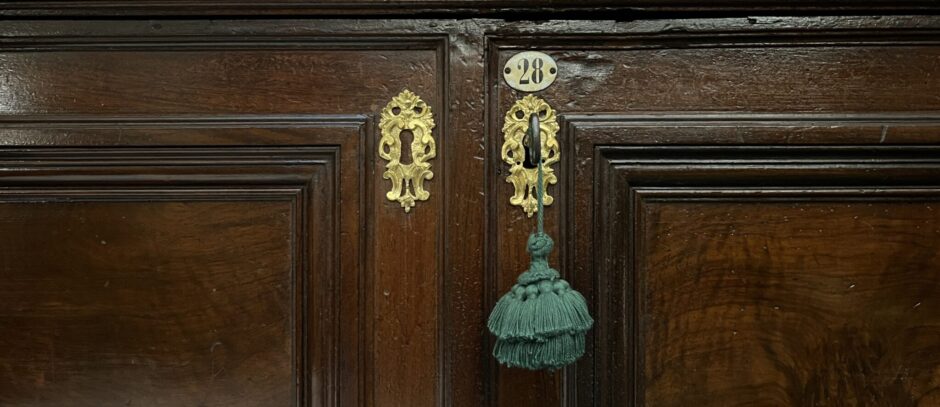 This is the Feast of the Transfiguration of Our Lord. Did you know that this feast was made a universal feast for the Western Church by Pope Callixtus III to commemorate the Siege of Belgrade in 1456?
This is the Feast of the Transfiguration of Our Lord. Did you know that this feast was made a universal feast for the Western Church by Pope Callixtus III to commemorate the Siege of Belgrade in 1456?
After the Muslims took Constantinople Sultan Mehmed II went next for Hungary, attacking first Belgrade. The siege turned into a counterattack which overran the Muslim camp. The invaders retreated. In Hungary, Catholic and old Protestant churches still ring bells in honor of the defeat of the Muslims. A fine day, indeed.
The word transfiguratio is interesting in itself. In classical, post-Augustan Latin Pliny used this for “a change of shape”. However, that is not what happened with Christ on the mountain, probably Mount Tabor in Galilee not far from Nazareth.
What happened?
If we see Christ’s Baptism at the Jordan as the beginning point of His public life, and the Ascension as the end, then the Transfiguration its zenith.
The accounts of the Transfiguration are found in Matthew 17:1-6, Mark 9:1-8, and Luke 9:28-36. Also, 2 Peter 1:16-18 and John 1:14 refer to it.
 Scripture tells us that a week or so after Jesus and the disciples were at Caesarea Philippi (where Christ gave Peter the “keys”) Jesus took Peter, James and John to a high mountain. They were surrounded by a bright cloud, like that in which God spoke to Moses. Christ shone with light so dazzling it was hard to see. On either side of Him were Moses the Lawgiver and Elijah the Prophet. A voice was heard, as at the time of Jesus’ Baptism: “This is my beloved Son, with whom I am well pleased; listen to him”. The Gospels of Matthew and Mark use the Greek word metemorphothe for what happened. St. Jerome in his Vulgate chose transfiguratus est. The Synoptic Gospels (Matthew, Mark and Luke) expand the event saying “his face did shine as the sun: and his garments became white as snow,” or “as light,” according to the Greek text. This brightness has been taken to be a glimpse of Christ’s divinity shining through His flesh. Christ allowed the three key Apostles to see this so as to strengthen them before His Passion soon to follow.
Scripture tells us that a week or so after Jesus and the disciples were at Caesarea Philippi (where Christ gave Peter the “keys”) Jesus took Peter, James and John to a high mountain. They were surrounded by a bright cloud, like that in which God spoke to Moses. Christ shone with light so dazzling it was hard to see. On either side of Him were Moses the Lawgiver and Elijah the Prophet. A voice was heard, as at the time of Jesus’ Baptism: “This is my beloved Son, with whom I am well pleased; listen to him”. The Gospels of Matthew and Mark use the Greek word metemorphothe for what happened. St. Jerome in his Vulgate chose transfiguratus est. The Synoptic Gospels (Matthew, Mark and Luke) expand the event saying “his face did shine as the sun: and his garments became white as snow,” or “as light,” according to the Greek text. This brightness has been taken to be a glimpse of Christ’s divinity shining through His flesh. Christ allowed the three key Apostles to see this so as to strengthen them before His Passion soon to follow.
Getting back to the word transfiguratio, it clearly points to a dramatic change, though in Christ’s case not one of form or shape. The word is from the preposition trans with figura. A figura is “a form, shape” but also in philosophical language a “quality, kind, nature, manner”. Most interesting to me is the mean of figura as a “form of a word” or “a figure of speech”. Think of the Prologue of the Gospel of John 1:14, recited by priests for centuries at the end of Holy Mass: “we have beheld his glory, glory as of the only Son from the Father”.
In the Prologue of John the Evangelist says that Jesus the Son is the divine logos, the Word: “In the beginning was the Word….” A word is an utterance which projects the concept of the speaker. The Jews has used Hebrew memra, God’s creative or directive word or speech which manifests His power in the mind or in matter, as a substitute for the divine Name of God.
Jerome’s choice of a word with the root figura or “figure of speech” is very apt in many ways, and its draws our imaginations into the realm of God’s eternal uttering, His eternal rhetoric.
COLLECT (Transfiguration):
Deus, qui fidei sacramenta
in Unigeniti tui gloriosa Transfiguratione
patrum testimonio roborasti,
et adoptionem filiorum perfectam mirabiliter praesignasti,
concede nobis famulis tuis,
ut, ipsius dilecti Filii tui vocem audientes,
eiusdem coheredes effici mereamur.
LITERAL WDTPRS VERSION:
O God, who in the glorious Transfiguration
of your Only-begotten Son
strengthened the sacrament of faith by the witness of the fathers (Moses and Elijah),
and in a marvelous way foreshadowed the perfect adoption of children,
grant to your servants that,
hearing the voice of Your beloved Son himself,
we may merit to be made the same Son’s coheirs.
NEW CORRECTED ICEL (2011):
O God, who in the glorious Transfiguration
of your Only Begotten Son
confirmed the mysteries of faith by the witness of the Fathers
and wonderfully prefigured our full adoption to sonship,
grant, we pray, to your servants,
that, listening to the voice of your beloved Son,
we may merit to become co-heirs with him.
In the Transfiguration, God reveals more fully the Sonship of Jesus and, thus, reveals in Jesus, our own sonship.
When the Father reveals the Son as Son, He is telling us about His own life, how He generates the Son and how the Holy Spirit from all eternity is the love between them. Fortified with this knowledge, we can participate in the life of the Trinity in a fuller way. Because of our unity with Christ in our common human nature, the way to divine sonship is opened up. He is the Father’s Son by nature, but we by grace. God makes us His children through a perfect adoption… adoptio perfecta. From God’s point of view, it is perfect (“brought to completion”) because God puts His seal and mark upon us. From our point of view, it will be perfect only when we see God face to face in heaven.
Because of this adoption, the adoptio filiorum and adoptio perfecta, an eternal inheritance awaits us. We merit a patrimony.
St. Leo the Great (+461) said in a sermon (s. 51):
“In this mystery of the Transfiguration, God’s Providence has laid a solid foundation for the hope of the Church, so that the whole body of Christ may know what a transformation will be granted to it, and that the members may be assured that they will be sharers in the glory which shone forth in their Head.”
We are already sons and daughters by God’s adoption, but that sonship is not yet completed.
We lack the final essential component: perseverance in faith and obedience for the whole course of our lives. Even the Apostle Peter, his eyes dazzled by the Lord on Mount Tabor, failed to see what was happening. The great St. Augustine in a sermon on the Transfiguration (s. 78, 6), addresses Peter, and through Peter he really addresses us: “Descend the mount, O Peter. You wanted to rest on the mountain. Come down.”
We still have work to do in this life before we can rest.
Citing the same passage of Augustine the CCC 556 takes up this same theme:
Peter did not yet understand this when he wanted to remain with Christ on the mountain. It has been reserved for you, Peter, but for after death. For now, Jesus says: “Go down to toil on earth, to serve on earth, to be scorned and crucified on earth. Life goes down to be killed; Bread goes down to suffer hunger; the Way goes down to be exhausted on his journey; the Spring goes down to suffer thirst; and you refuse to suffer?”


































In a Bishop Sheen book, “Those Mysterious Priest” he has a section on the Transfiguration. It is in Chapter 16, The Priest and the World. It is quite revealing toward our Church’s current plight regarding its relationship to the world. Worth the read!
It is striking how this (form of the) collect has seemingly been varied from the EF form. There, “perfectam” is followed by “voce delapsa in nube lucida” as how the Father, implicitly the ‘Thou’ or ‘You’ addressed, “mirabiliter praesignasti”. That detail itself become implicit in this version, where “dilecti Filii tui vocem audientes, eiusdem coheredes effici mereamur” now stands, where “Regis gloriae nos cohaeredes efficias, et eiusdem gloriae tribuas esse consortes” stands in the other. That partial ‘unpacking’ in the final clause of “adoptionem filiorum perfectam” and “cohaeredes” is in this way also left implicit.
Origen, in his commentary on Matthew (XII, 43: as translated at New Advent), interestingly writes that “in regard to the bare meaning of the letter, Moses and Elijah, having appeared in glory and talked with Jesus, went away to the place from which they had come, perhaps to communicate the words which Jesus spoke with them, to those who were to be benefited by Him, almost immediately, namely, at the time of the passion, when many bodies of the saints that had fallen asleep, their tombs being opened, were to go to the city which is truly holy — not the Jerusalem which Jesus wept over— and there appear unto many [Matthew 27:52-53]”.
Moses and Elijah, as in their degree “gloriae consortes”, were yet also awaiting the full perfection of “adoptionem filiorum perfectam”.
I have a wonderful book of sermons by Gregory Palamas, a 14th century Greek saint and archbishop of Thessoloniki. In Homily 34, St. Gregory says: “The King of all is everywhere, and so is his kingdom, so the coming of His kingdom does not mean that it arrives here from somewhere else, but that it is revealed through the power of the divine Spirit.” He continues:
“The light of the Lord’s transfiguration does not come into being or cease to be, nor is it circumscribed or perceptible to the senses, even though for a short time on the narrow mountain top it was seen by human eyes. Rather, at that moment, the initiated disciples of the Lord ‘passed’, as we have been taught, ‘from flesh to spirit’ by the transformation of their senses, which the Spirit wrought in them, and so they saw that ineffable light, when and as much as the Holy Spirit’s power granted them to do so.”
Coincidentally, the whole sermon can be found on the website of the Orthodox Church of America (OCA). It is a sublime masterpiece by a great theologian.
On reading this, I am once again perplexed as to why some people find the 2011 Collect translations unintelligible. If so, they would be better employed in private devotions (as Pius XII said, recognizing that there were those whose level of education did not furnish them with the wherewithal to fully understand the Mass prayers even in translation). My only complaint is that where the Latin has a simple imperative, someone (Vox Clara perhaps?) saw fit to insert ‘we pray’ when ‘quaesumus’ or its equivalent is not in the original. This happens too often to be accidental. I can only assume that the redactors thought that the imperative would sound too impolite.
Of course a savvy priest could leave the offending words out, but without the advantage of the Latin on the facing page he would have to do a lot of cross-referencing.